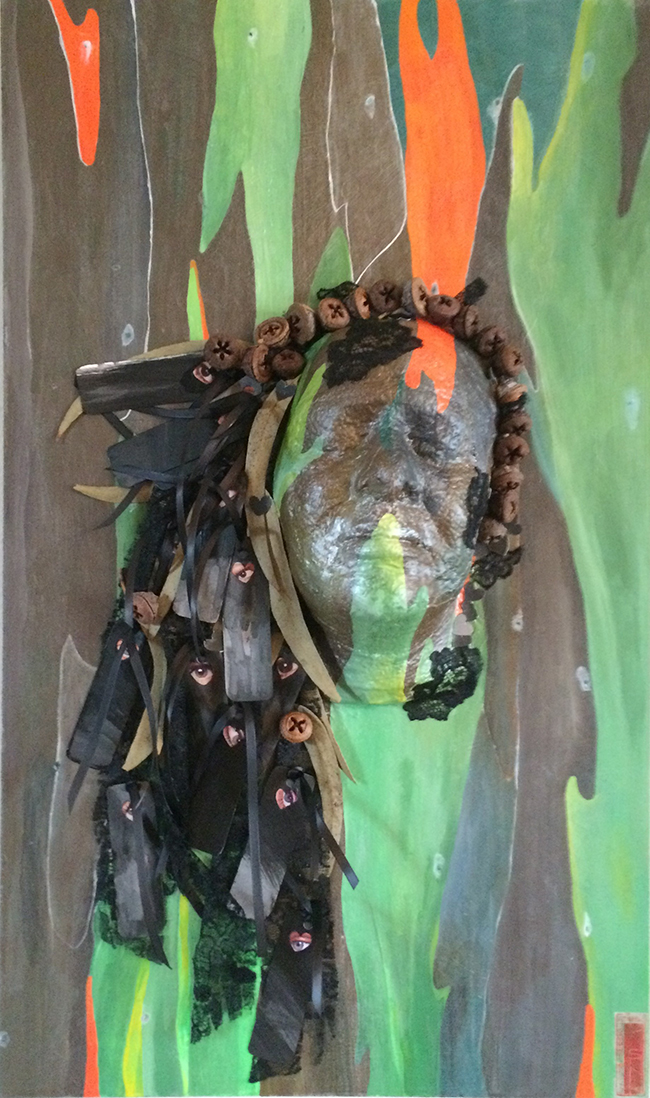Deborah K. Tash was born in 1949, raised in the Bay Area, and has spent a lifetime weaving together poetry and visual art. She describes herself as a Mestiza, pulling from her Mexican heritage on her mother’s side and Celtic roots on her father’s. That blend runs deep. It’s not just about ancestry—it’s about spirit, story, nature, and the spaces in between. Her work doesn’t separate those worlds. Instead, it tries to hold them all at once.

Tash is both a poet and a visual artist, and she lets the two forms speak to each other. One inspires the other. Her process is grounded in something old—ancient, even—and deeply personal. Her recent mixed media painting, Ancestor Song in Green, is a good example. It’s a layered piece: a mask painted over an abstract background inspired by eucalyptus bark, with seedpods, lace, ribbons, and small eye icons floating around the edges. Each element carries meaning. Each one ties into her poem by the same name.
The poem speaks in images—ghosts, wind, stones, owls. It reads like a quiet incantation, calling something forward. Tash doesn’t treat her materials as props. The eucalyptus bark, for instance, isn’t just a texture. It’s a presence, a “signature” of something living, something watching. The mask is more than an object—it’s a spirit door. A bridge. A way to listen.
This act of listening, of paying attention to the in-between places, sits at the heart of what she does. The ancestors in the poem are waiting. They ride the wind. They ask for acknowledgment, not in some loud or dramatic way, but in quiet, everyday things: prayer, thanksgiving, intention. That’s where Tash places her focus—in the unseen details, the symbolic textures that live close to the skin and deep in the blood.
Her art isn’t flashy. It’s built from layers—materials with weight, history, and memory. She uses gesso, seedpods, lace, ribbons. She doesn’t just paint over a canvas; she builds it up, piece by piece, until it holds what she needs it to. She’s not after perfection. She’s after connection. She’s chasing that feeling of being in two worlds at once: the material and the mystical.
Color plays a big role too. The eucalyptus painting uses greens and reds—earthy, vivid, alive. These colors don’t scream; they hum. They create a pulse in the work. It’s not about realism. It’s about atmosphere. The green isn’t just a background—it’s the breath of the piece. It holds the memory. It holds the invitation to enter.
Tash’s work deals with duality—life and death, presence and absence, fear and reverence. The poem talks about unravelling fear, about sacred spirals, about remembering what’s already true. That phrase—what is already—feels important. She’s not inventing something new. She’s remembering something ancient. Her art is less about decoration and more about revelation. It asks you to slow down. To feel your own cellular memory stirring.
She isn’t creating in a vacuum. Her work is tied to land, to nature, to family lines and spirit guides. The owl shows up in her poem not as a symbol of wisdom in the generic sense, but as a presence—something that calls, something that knows. The mask becomes a way to hold that knowing. A way to let it live on the wall, in the room, in your bones.
Tash is doing something many artists try to do—bridge the inner world and the outer one—but she does it without noise. She trusts her materials, her ancestors, her process. She brings together her heritage, her identity, and her years of creating with a kind of soft insistence. She isn’t here to sell you a message. She’s here to share a portal. You can step through it or not. But it’s there, waiting.
Like the mask in her poem, her art waits quietly, “unravelling fear and reticence.” It’s not trying to dominate the room. It’s offering a door. You can walk in with gratitude, with questions, with silence.
Deborah K. Tash lives at the meeting point between visual and verbal, human and spirit, bark and breath. And from that place, she keeps making work that remembers. Work that honors. Work that asks you to listen.

